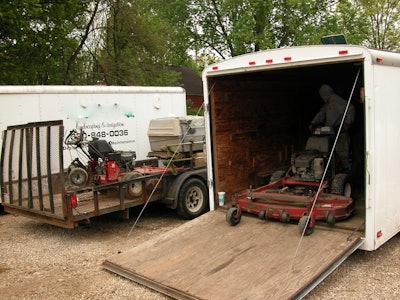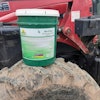
You've been in business three years and your company just secured its first line of credit. The question is: How can I use that line of credit to my advantage without abusing it? Is it an insurance policy to help offset a bad year? Can I grow my business and set up a new crew? Is it something I can use to take advantage of a good deal on a used truck?
The answer to all three of those questions is "yes, maybe". But in truth, a line of credit should be used more strategically, say veteran green industry consultants.
“A line of credit is designed for short-term liquidity needs, something a landscape contractor would use for maybe 90 to 120 days,” explains longtime green industry consultant Frank Ross. “Companies can use it to ramp up for spring, make up for a cash flow shortfall if customers are not paying on time, or apply it to overhead when there’s a lull in the business. The important thing to remember is that most banks will want you to pay back anything owed on the line at the end of the year, and rest it for a couple of months before accessing the line again.
“It shouldn’t be used for capitalization of the company," Ross goes onto say. "In fact, if you need to access the line of credit year around, than either the company is undercapitalized or not making enough profit.”
You gotta' pay it back fairly quickly
Echoing Ross, industry consultant and former landscape contractor Rod Bailey emphasizes that failing to pay off a credit line at the end of the year is not only a red flag to the bank, it’s also a red flag to the business owner. Says Bailey, “Likely, it’s an indicator that the money has been misused in some way or the business is growing too fast; growing businesses suck up cash. Either way, it’s an issue that needs to be addressed quickly.”
One way to avoid being in this position is to do a cash flow projection when preparing an annual budget, Bailey points out. Determine when the extra cash is needed and use it then. The projection will also indicate when you will be able to pay the money back.
When asked what’s the difference between good and bad debt, Bailey laughed and said simply, “A bad debt is one you can’t pay back or is costing a lot of interest. A line of credit might fall into that category if it’s not paid off and the bank terms it out at the end of the year, i.e., converts the balance to a long-term loan.”
Hard times and sweet deals
All the talk about meeting cash flow demands doesn’t mean a line of credit can’t be used for something else, Ross adds. “I like to compare it to a vitamin B-12 shot for a company, something that will get it through a hard time. No, I don’t recommend it for capitalization, such as buying new equipment, as there’s other financing that is available for that purpose, anyway. Again, no matter what it is used for, the key is to pay it back at year end.”
Industry veteran Mike Rorie, president of Ohio-based GroundSystems, agrees. “How much your line of credit is and how it is used depends in large part on how profitable your company is. If it is very profitable and can easily pay off what has been borrowed, then the credit line provides added flexibility.
“Maybe there’s a $7,000 trailer for sale and if you can write a check for it today, the seller will offer a discount," Rorie continues. "A line of credit will give the ability to take advantage of the offer. Over the years, I’ve even used a credit line to make small business acquisitions, but that’s not the normal way a credit line is used. A credit line is there so the business owner is not inhibited by a lack of funds. My rule of thumb and advice I give to other contractors is to have a line that covers one to two months of operating a business, or can cash flow three months of receivables.”
Rorie, Ross and Bailey all emphasize that growing a business, e.g., leasing new space, buying equipment, upgrading a computer system and so forth, will usually require some longer-term borrowing.
Other scenarios to think about
Spring ramp-up, slow-paying customers and business lulls are likely reasons to have a line of credit. But there are other scenarios.
Roscoe Klausing, owner of Kentucky-based the Klausing Group, has operated with a line of credit for 16 years. He started his landscape management company in 1992, while still in high school, and secured his first line of credit in 2000, when he was just in his early 20s.
Many people in this industry start a business just as Klausing did; part-time and growing slowly. They couldn’t get a line of credit early on, but they didn’t need one either. Klausing explains, “When I started mowing lawns, I was paid per service. If I mowed a lawn four times in the month, I was either paid after every time I mowed or I billed my customers at the end of the month. Cash flow wasn’t a real issue for me. As I grew, though, I offered a few more services, and took on customers who wanted to budget their landscape management costs over 12 months.
“I brought in an equal amount of revenue every month, but starting in May, the services I delivered were of greater value than the money coming in," Klausing continues. "Suddenly, cash flow became an issue; I was essentially upside down for six months and needed additional funds to help meet payroll and other expenses.”
For the past 16 years, Klausing has done what the above industry experts advised: zero out any balance on the line of credit at year end. Only in the worst of the economic downturns was a balance carried from one year to the next.
A few more helpful hints
Although the ideal standard, as Rorie has indicated, is to have a line that can cover three months of average receivables, Klausing said his company has managed well with a line that is 10% of his company’s annual revenue. How big the line is, he points out, depends on your needs along with profitability, as most credit lines are secured on business assets. Klausing offers a couple of other hints for landscape contractors looking to put their credit lines to good use.
The banking environment has changed, and banks have become more serious about borrowers zeroing out their balance at year end. If they can’t, banks can term out the unpaid balance and reduce the available line of credit for the next year.
A one-year revolving line of credit is more commonplace, today. Every 12 months, banks may ask borrowers to reapply for the credit line, essentially forcing them to prove their financial health every year.
Finally, Klausing emphasizes that a line of credit resembles a credit card in one way, in that it can give users a false sense of security. If you just pay the monthly interest, there will eventually be an unpleasant surprise later on.
Bailey’s suggestion, that being strategic and knowing well ahead of time when cash flow will need a boost, is one way to avoid surprises. “Having a budget with cash flow projections will indicate when your business needs the extra funds, and in landscape maintenance that’s usually in early summer to cover additional labor costs," Bailey points out.
Another way to avoid surprises, Bailey adds, is to be even more strategic and put together a five-year plan. In other words, savvy business owners don’t wait for a misused credit line (or the banker) to tell them they’re growing too fast or aren’t being profitable enough. Planning for reasonable and profitable growth will minimize those kinds of 11th-hour surprises.




















